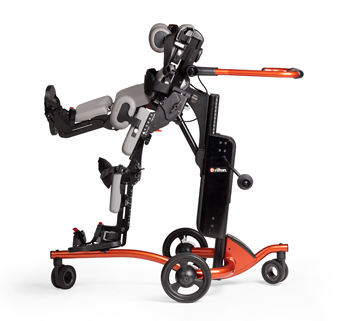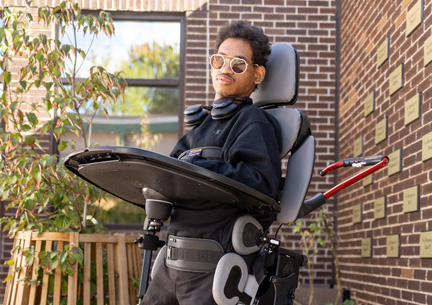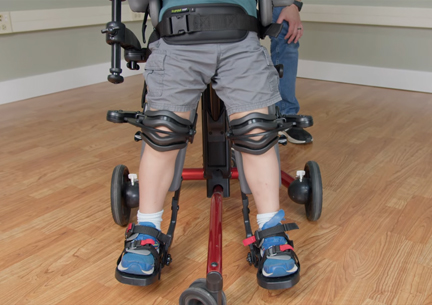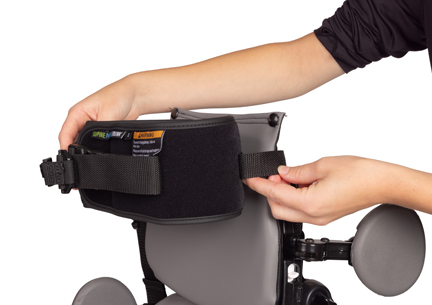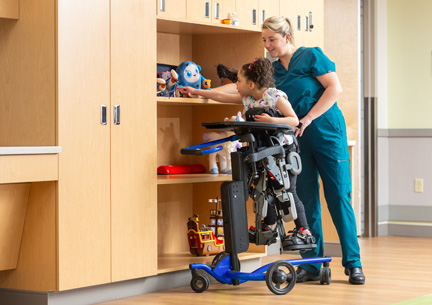Choosing Between Adaptive Standing Frames
| September 2025 Many people with neuromuscular disabilities benefit from adaptive standing programs. People with diagnoses ranging from cerebral palsy to spinal cord injury or muscular dystrophy can benefit, as research shows that standing improves musculoskeletal development, postural control, bowel and bladder function, and respiration; it also reduces tone and improves participation.
Many people with neuromuscular disabilities benefit from adaptive standing programs. People with diagnoses ranging from cerebral palsy to spinal cord injury or muscular dystrophy can benefit, as research shows that standing improves musculoskeletal development, postural control, bowel and bladder function, and respiration; it also reduces tone and improves participation.
Selecting the right standing frame is crucial for optimizing outcomes. Rifton manufactures a Multi-Position Stander (providing both supine and prone standing options) and a Mobile Stander. Understanding prone vs supine positioning is essential when choosing equipment: prone standers support the body from the front while tilting toward vertical, while supine standers support from behind. Here are some guidelines to assist with choosing the most appropriate adaptive stander.
Rifton Supine Stander
 The supine stander configuration provides upright weight-bearing opportunities for people with medical complexity. These individuals have typically been bedridden for a long time or have significant musculoskeletal weakness, lacking upper trunk and head control. The angle adjustments on this standing frame allow the user to be safely assisted into the standing position, which initiates weight-bearing through the lower extremities. The upright position allows for increased social interaction and involvement in a wide range of therapeutic, educational, and recreational activities. Standing changes how individuals see and experience the world.
The supine stander configuration provides upright weight-bearing opportunities for people with medical complexity. These individuals have typically been bedridden for a long time or have significant musculoskeletal weakness, lacking upper trunk and head control. The angle adjustments on this standing frame allow the user to be safely assisted into the standing position, which initiates weight-bearing through the lower extremities. The upright position allows for increased social interaction and involvement in a wide range of therapeutic, educational, and recreational activities. Standing changes how individuals see and experience the world.
Why Use a Supine Stander?
-
Standing option for people with medical complexity:
The firm trunk, head, and leg supports of the supine stander provide posterior stability for individuals with significant musculoskeletal weakness or those with a tracheostomy. The quick and easy adjustments of the supine stander accommodate leg length discrepancies, hip abduction positioning, and joint contractures. Additionally, a wide range of customized supports offers comfortable and secure positioning for the most involved individuals as they are moved into the upright position. -
Gradual progression to an upright position:
The easy angle adjustment of the supine stander provides gradual movement from the fully horizontal position to the upright position. This is helpful for individuals who have been bedridden for a long time, those presenting with orthostatic hypotension, or individuals working towards improved trunk and head control. Additionally, the angle adjustment has indicators to allow for accurate positioning and monitoring of weight-bearing progression. -
Upright interaction:
The supine stander adjusts in height, bringing a person down to floor level or up to a high countertop. This allows for face-to-face communication and interactions. -
Easy transfers:
Combining the height adjustment of the supine stander with the horizontal angle position allows the stander to be placed at the optimum height for transfers from a wheelchair or a bed. -
Improving head and trunk control:
The head support on the supine stander can be removed, and the trunk support can be lowered to allow the user opportunities to improve head and trunk control. This is usually approached alongside the reduction of the positioning supports.
Rifton Prone Stander
 The prone stander configuration is a therapeutic progression from the supine stander. It is typically appropriate for individuals with adequate upper trunk and head control, or those who do not require a head support to maintain an upright head position. The prone stander gives users the added challenge of working their trunk and neck muscles against gravity for better postural control. The angle-adjustable body support provides anterior stability while encouraging gradual weight-bearing. The prone position also has height adjustment, and like the supine stander, accommodates leg length discrepancies, hip abduction requirements, and joint contractures. It is a great stander for advancing eye-level interactions and more complex head and upper extremity control.
The prone stander configuration is a therapeutic progression from the supine stander. It is typically appropriate for individuals with adequate upper trunk and head control, or those who do not require a head support to maintain an upright head position. The prone stander gives users the added challenge of working their trunk and neck muscles against gravity for better postural control. The angle-adjustable body support provides anterior stability while encouraging gradual weight-bearing. The prone position also has height adjustment, and like the supine stander, accommodates leg length discrepancies, hip abduction requirements, and joint contractures. It is a great stander for advancing eye-level interactions and more complex head and upper extremity control.
Why Use a Prone Stander?
-
Upright social interaction:
With adjustability from horizontal to 90 degrees of upright positioning, the prone stander offers users the opportunity to be at eye-level with their peers and participate in activities while still being adequately supported at the trunk. -
Improving head and trunk control:
The adjustable forward tilt of the prone stander engages the pull of gravity on the head and upper trunk, cueing the use of the neck and trunk extensor muscles to maintain an upright head position. Increasing the angle of the prone stander increases the postural challenge to the head and upper trunk. -
Minimize extensor tone:
For individuals with strong extensor tone, the angle of the prone stander can use gravity to help reduce excessive extension. -
Pressure relief:
By supporting a person at the front, a prone stander offers a beneficial temporary alternative to wheelchair positioning, relieving pressure on the ischial tuberosities and other areas susceptible to skin breakdown. -
Gradual increase in weight-bearing:
The easy angle adjustment of the prone stander provides gradual movement from a horizontal position to the upright position. The angle adjustment has indicators for accurate positioning and monitoring of weight-bearing progression. -
Improved hip extension and alignment:
By virtue of the firm anterior support, a prone stander is best situated to encourage the hip joint into full extension. -
Easy transfers:
Specific to the Rifton prone stander, the standing frame design allows for close proximity of wheelchairs and Activity Chairs – allowing caregivers to place a person’s feet directly on the stander sandals and perform a sit-to-stand transfer out of the chair directly into the stander.
The Rifton Multi-Position Stander
 The Multi-Position Stander offers both supine and prone standing options in one device. The unique design of the Rifton standing frame makes the conversion from a supine stander to a prone stander (or vice versa) simple, quick, and easy. A multi-position stander is indicated when the stander will be used by multiple individuals, such as in a school setting where each person requires different positioning. Additionally, a multi-position stander is indicated for a person who demonstrates potential to progress quickly in therapy.
The Multi-Position Stander offers both supine and prone standing options in one device. The unique design of the Rifton standing frame makes the conversion from a supine stander to a prone stander (or vice versa) simple, quick, and easy. A multi-position stander is indicated when the stander will be used by multiple individuals, such as in a school setting where each person requires different positioning. Additionally, a multi-position stander is indicated for a person who demonstrates potential to progress quickly in therapy.
Rifton Mobile Stander
 Often considered a therapeutic progression from a Prone Stander, the Mobile Stander facilitates more vertical posturing, with weight-bearing and balance challenges similar to those experienced with independent standing. This is especially true if the device is used in reverse. With its large wheels, the Mobile Stander allows for self-propelled exploration and freedom. With the large wheels removed, the stander provides better access to tabletop activities. With this range of possibilities, users can easily interact with their peers and their environments while simultaneously benefiting from challenges to weight-shifting, balance, and postural control.
Often considered a therapeutic progression from a Prone Stander, the Mobile Stander facilitates more vertical posturing, with weight-bearing and balance challenges similar to those experienced with independent standing. This is especially true if the device is used in reverse. With its large wheels, the Mobile Stander allows for self-propelled exploration and freedom. With the large wheels removed, the stander provides better access to tabletop activities. With this range of possibilities, users can easily interact with their peers and their environments while simultaneously benefiting from challenges to weight-shifting, balance, and postural control.
Why Use a Mobile Stander?
-
For social interaction and independent mobility:
The Mobile Stander combines upright positioning with self-propelled mobility, facilitating eye-level interaction, participation, and independent movement. -
Improve weight-bearing:
The Mobile Stander offers a seat support that adjusts to accommodate partial to full weight-bearing. The seat support is also useful in positioning individuals with lower extremity contractures who benefit from upright mobility. -
Improve weight-shifting and postural control:
The self-propelled mobility offered by the Mobile Stander stimulates postural righting reactions and weight shifting. -
Improve trunk control:
The adjustable body support on the Mobile Stander can be lowered to promote independent trunk control. Additionally, the Mobile Stander can be used in the reverse position to further challenge trunk control.
Learn More About Adaptive Standing Frames
 Adaptive standing improves quality of life for people with neuromuscular disabilities. A full understanding of the benefits of therapeutic standing can help a practitioner provide this quality of care as well as acquire funding for appropriate adaptive standing equipment.
Adaptive standing improves quality of life for people with neuromuscular disabilities. A full understanding of the benefits of therapeutic standing can help a practitioner provide this quality of care as well as acquire funding for appropriate adaptive standing equipment.
